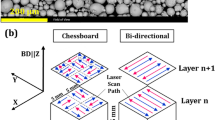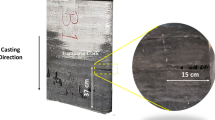The hot ductility of Nb, Ti, and Nb-Ti containing steels has been studied under direct-cast conditions. A Gleeble 3500 thermomechanical simulator was used to determine hot ductility over the temperature range 1100 °C to 700 °C at a low strain rate of 7.5 × 10−4 s−1. Tensile samples were cooled at two different cooling rates, 100 °C/min and 200 °C/min, simulating, respectively, thick and thin slab casting processes. Complex thermal patterns designed to simulate the cooling conditions experienced near the surface of a slab during continuous casting were carried out for the Nb-Ti steel. The Nb-Ti steel had lower ductility than both the Nb and Ti steels. Increasing the cooling rate generally deteriorated ductility. The low recovery of ductility at higher temperatures is explained in terms of a low strain rate and fine precipitation delaying the onset of dynamic recrystallization. This can promote intergranular cracking as a result of grain boundary sliding in the austenite. At lower temperatures, ductility was further reduced due to the formation of thin ferrite films at the prior austenite grain boundaries. Simulating the thermal history experienced near the surface of thin (90 mm) cast slab improved ductility of the Nb-Ti steel by promoting coarser NbTi(C,N). This exposes a potential flaw in a simplified hot-ductility test: a failure to accurately represent the influence of the thermomechanical schedule on precipitation and, hence, hot ductility.








Similar content being viewed by others
Notes
PHILIPS is a trademark of Philips Electronic Instruments Corp., Mahwah, NJ.
JEOL is a trademark of Japan Electron Optics Ltd., Tokyo.
References
Y. Maehara, K. Yasumoto, H. Tomono, T. Nagamichi, Y. Ohmori: Mater. Sci. Technol., 1990, vol. 6 (9), pp. 793–806
R. Abushosha, O. Comineli, B. Mintz: Mater. Sci. Technol., 1999, vol. 15 (3), pp. 278–86
R. Abushosha, S. Ayyad, B. Mintz: Mater. Sci. Technol., 1998, vol. 14 (4), pp. 346–51
B. Mintz, S. Yue, J.J. Jonas: Int. Mater. Rev., 1991, vol. 36 (5), pp. 187–217
B. Mintz, R. Abushosha: Mater. Sci. Technol., 1992, vol. 8 (2), pp. 171–77
B. Mintz: ISIJ Int., 1999, vol. 39 (9), pp. 833–55
R. Abushosha, R. Vipond, B. Mintz: Mater. Sci. Technol., 1991, vol. 7 (7), pp. 613–21
T.N. Baker: Titanium Technology in Microalloyed Steels, The Institute of Materials, London, 1997, pp. 98–113
O. Comineli, R. Abushosha, B. Mintz: Mater. Sci. Technol., 1999, vol. 15 (9), pp. 1058–68
B. Mintz: Ironmaking and Steelmaking, 2000, vol. 27 (5), pp. 343–47
P.A. Manohar and M. Ferry: Proc. Materials 98, Biennial Conf. of the Institute of Materials Engineering Australasia, Ltd., Wollongong, Australia, 1988, pp. 131–38
R. Abushosha, R. Vipond, B. Mintz: Mater. Sci. Technol., 1991, vol. 7 (12), pp. 1101–07
H. Zou, J.S. Kirkaldy: Metall. Trans. A, 1991, vol. 22A, pp. 1511–24
S. Okaguchi, T. Hashimoto: ISIJ Int., 1992, vol. 32 (3), pp. 283–90
H. Luo, L.P. Karjalainen, D. Porter, H. Limatainen, Y. Zhang: ISIJ Int., 2002, vol. 42 (3), pp. 273–82
C.R. Killmore: BlueScope Steel, Port Kembla, Australia, private communication, 2002
B. Mintz: Mater. Sci. Technol., 1996, vol. 12 (2), pp. 132–38
A. Cowley, R. Abushosha, B. Mintz: Mater. Sci. Technol., 1998, vol. 14 (11), pp. 1145–53
K.W. Andrews: J. Iron Steel Inst., 1965, vol. 203, pp. 721–27
B. Mintz, R. Abushosha, O. Comineli, and S. Ayyad: Proc. 7th Int. Symp. on Physical Simulation of Casting, Hot Rolling and Welding, National Research Institute of Japan, Tsukuba, Japan, 1997, pp. 449–59
B. Mintz, J.M. Stewart, D.N. Crowther: ISIJ Int., 1987, vol. 27, pp. 959–64.
Acknowledgments
The authors thank the Australian Research Council and BlueScope Steel for financial support under an ARC-Linkage Grant. Special thanks are due to Mr. Robert De Jong for his assistance with the Gleeble tests and Mr. Greg Tillman for his assistance with metallographic techniques. We also thank Professor Paul Munroe for his assistance with the use of TEM facilities at the UNSW (Sydney, Australia). We thank the University of Wollongong for the provision of laboratory facilities and permission to publish our results.
Author information
Authors and Affiliations
Corresponding author
Additional information
Manuscript submitted May 6, 2008.
Rights and permissions
About this article
Cite this article
Carpenter, K., Dippenaar, R. & Killmore, C. Hot Ductility of Nb- and Ti-Bearing Microalloyed Steels and the Influence of Thermal History. Metall Mater Trans A 40, 573–580 (2009). https://doi.org/10.1007/s11661-008-9749-1
Published:
Issue Date:
DOI: https://doi.org/10.1007/s11661-008-9749-1




